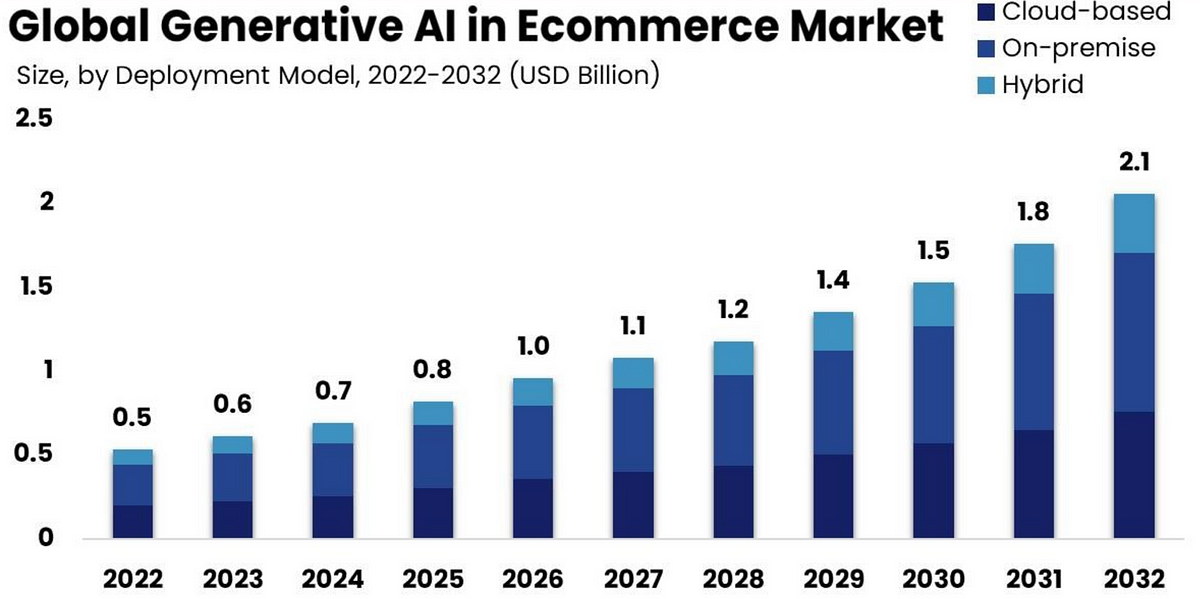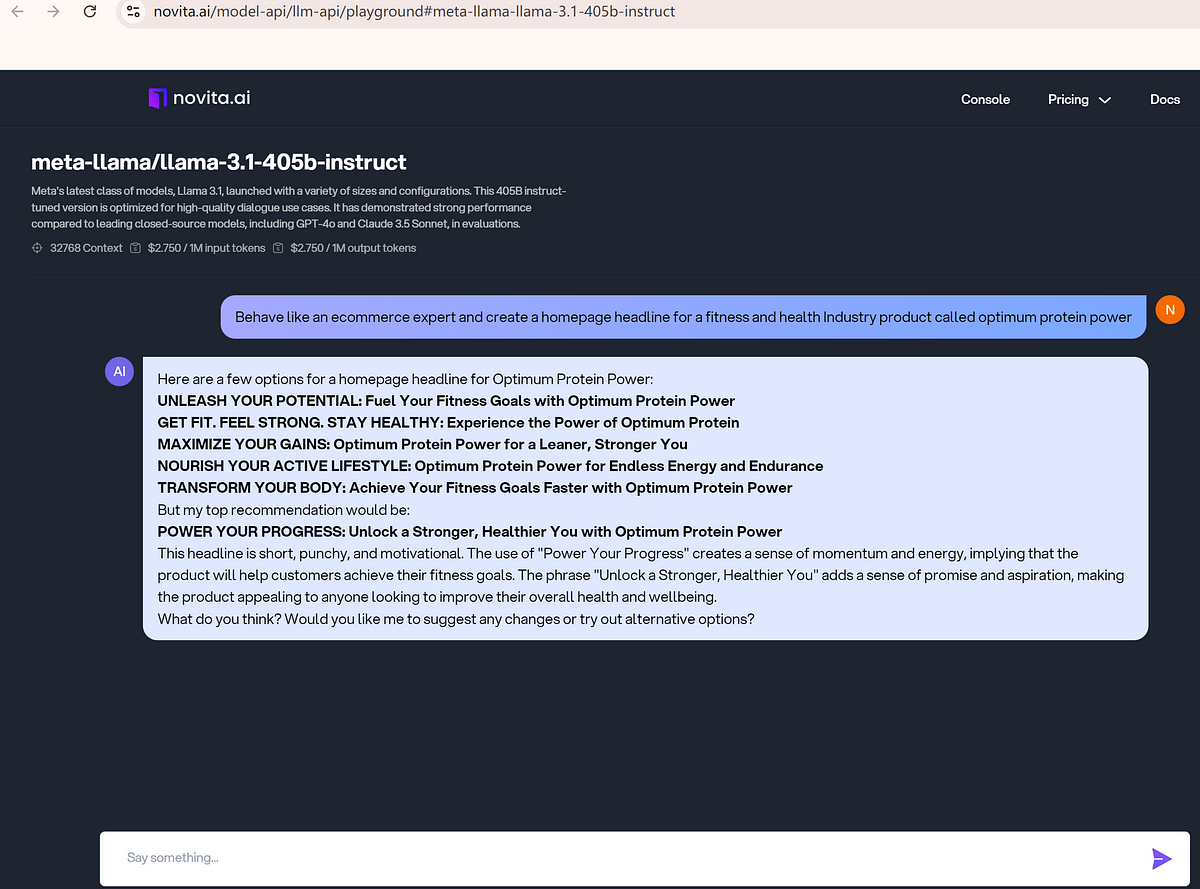Mastering Generative AI in Ecommerce: Benefits and Applications

If you're looking for information about generative AI in ecommerce. Learn how it is used in online shopping applications in our blog!
Key Highlights
- Generative AI is a seismic shift in e-commerce platforms’ interactions and services with consumers.
- This technology can provide highly personalized content, recommendations, and automation solutions for most e-commerce businesses.
- By leveraging the power of generative AI, e-commerce companies can enhance the customer experience, improve operational efficiency, and drive greater customer engagement and loyalty.
- In the future, generative AI will also play a more diverse and extensive role in e-commerce, and developers can follow the latest news
Introduction
In the e-commerce industry, generative artificial intelligence has become an important force. This technology has revolutionized how e-commerce platforms interact with customers and optimize how they operate. Generative AI enables personalized content creation and recommendations to enhance customer satisfaction and operational efficiency. The brand effect and conversion rate are also improved.
This blog will explore what generative artificial intelligence is, as well as its advantages, application scenarios, and challenges. Understanding this technology will help e-commerce businesses achieve more.
Exploring Generative AI in ECommerce
What’s generative AI?
Generative AI is the branch of artificial intelligence that focuses on creating various forms of content like text, images, video, answers, voice, and code. These models are trained on vast data sets to understand patterns and nuances in the input examples. They produce unique output demonstrating creativity and problem-solving akin to human intelligence.
How does Generative AI relate to LLM?
LLMs are a specific type of generative AI focused on processing and generating human language. LLMs are trained on vast amounts of text data and can perform various language-related tasks, including blog writing, text summarizing, translating, and answering queries. LLMs are a subset of generative AI, specifically designed for text generation and understanding. LLMs and other generative models (like those for images) use similar techniques, such as deep learning and neural networks, but LLMs are tailored for linguistic tasks.
Generative AI in ECommerce Market Size
The global Generative AI in E-Commerce Market has seen significant growth, with projections reaching USD 0.6 billion in 2023 and expected to rise to USD 2.1 billion by 2032 at a CAGR of 14.9%.

Driving Forces
- Demand for personalized shopping experiences,
- Improved inventory management
- AI integration in e-commerce
- Pricing strategies
Benefits of Generative AI in ECommerce
As you can see above, the market size of Generative AI in ecommerce is growing continuously. Let’s see the benefits that drive the business growth of it.
Cost-Efficient Operations
Generative AI for eCommerce becomes a cost-effective ally by utilizing automation, streamlining, and ensuring customer satisfaction. It aids businesses in resource management.
Personalized Shopping Experiences
Generative AI assists in creating unique and personalized customer experiences by tailoring customer interactions to their preferences.
Improved Conversion Rates
Generative AI in eCommerce boosts conversion rates significantly. McKinsey reports revenue increases of 3–15% and sales ROI improvements of 10–20% for AI-invested businesses. By analyzing browsing and purchase data, AI identifies customer patterns, preferences, and similarities. This enables tailored marketing campaigns and relevant product suggestions.
Innovation and Appeal to Customers
In a crowded market, generative AI can enhance businesses by providing unique online shopping experiences. Fashion brands can use generative AI for custom clothing options, letting customers design their garments like choosing a polka dot pattern for a shirt.
Use Cases of Generative AI in ECommerce
Dynamic Content Creation
Generative AI can create product descriptions, marketing copy, and social media posts, saving time and resources for eCommerce businesses. The new content is based on natural language processing, boosting customer retention.

Chatbots Support
Generative AI in eCommerce has improved manual customer service with automation and chatbots. AI-powered chatbots can handle customer inquiries 24/7, providing instant customer support and improving customer service efficiency.

Inventory Management
AI algorithms can predict demand trends, helping businesses manage inventory more effectively and reduce overstock or stockouts.
Dynamic Pricing
Generative AI can analyze market conditions and competitor pricing to optimize pricing strategies in real time, maximizing revenue.

Visual Assistant
The use of AI can enable customers to get search results like new products using images, enhancing the shopping experience and increasing conversion rates. In fashion and beauty, generative AI can create virtual fitting rooms, allowing customers to visualize products before purchase.
Fraud Detection
This valuable tool can detect and prevent fraudulent activities with advanced technology. AI swiftly analyzes transaction patterns to identify anomalies in real-time, flagging potential fraud to protect businesses and customers from financial losses and breaches.
Enhanced Marketing Strategies
These tools help analyse consumer behaviour and preferences. Marketers can use AI to optimize campaigns, target the right audience with personalized messages, and identify trends in real-time data, targeting the right audience with the right message without much marketing effort.

Sample Code
from openai import OpenAI
client = OpenAI(
base_url="https://api.novita.ai/v3/openai",
# Get the Novita AI API Key by referring: /docs/get-started/quickstart.htmll#_3-create-an-api-key
api_key="
)
model = "meta-llama/llama-3.1-405b-instruct"
stream = True # or False
max_tokens = 512
chat_completion_res = client.chat.completions.create(
model=model,
messages=[
{
"role": "system",
"content": "Act like you are a helpful assistant.",
},
{
"role": "user",
"content": "Hi there!",
}
],
stream=stream,
max_tokens=max_tokens,
)
if stream:
for chunk in chat_completion_res:
print(chunk.choices[0].delta.content or "", end="")
else:
print(chat_completion_res.choices[0].message.content)
Generative AI in Ecommerce: Case Studies
Amazon

The ecommerce brand Amazon introduced a generative AI chatbot in 2023 to enhance product discovery by summarizing reviews, highlighting key attributes, and assisting in finding well-fitting clothes. Personalized product recommendations are made by analyzing relevant data like browsing history and purchase records.
Shopify

This company uses generative AI combined with the information that users provide to produce recommendations for content like product descriptions, email subject lines, and headings on the ecommerce store.
Stitch Fix

Stitch Fix has nearly 4.5 billion text data points from client interactions, including style preferences and fit feedback. Using generative AI, Stitch Fix can quickly summarize and make sense of massive text data. The generative AI generates clothing recommendations based on client feedback. This information will be given by human stylists for clients.
eBay

eBay’s AI tool analyzes images, titles, and categories to create product descriptions. It suggests listing prices and shipping costs, making product listings competitive and informative for buyers. This tool helps buy and sell rare or collectable items, providing detailed information like manufacturer, set, league/team, and year for trading cards.
Walmart

Walmart has implemented generative AI to provide its employees with additional information to enhance customer service in business operations. This technology acts as a quick reference guide during customer interactions, consolidating all necessary tools for employees to provide personalized responses to product inquiries.
Technical Elements of Developing Generative AI in Ecommerce
1. Data Collection and Preprocessing
Gather comprehensive datasets that include user behaviour, historical sales data, product information, customer feedback, and market trends. Clean and preprocess data to handle missing values, and outliers, and to normalize data formats for consistency.
2. Machine Learning and Deep Learning Frameworks
- Framework Selection: Familiarity with popular machine learning and deep learning frameworks like TensorFlow, and PyTorch for building and training generative models.
- Algorithm Understanding: Mastery of the principles and applications of generative models such as Generative Adversarial Networks (GANs) and Variational Autoencoders (VAEs).
3. High-Performance Computing Resources
High-performance GPU instances are essential for training and deploying AI models as they speed up the processing of large datasets and complex computations in generative AI.
Novita AI GPU Instance is a leading cloud-based solution. It features high-performance GPUs such as NVIDIA A100 SXM and RTX 4090, benefiting PyTorch users needing extra computational power without investing in local hardware.

Additionally, the cloud infrastructure is flexible and scalable, enabling developers to have different GPU configuration options based on project needs. Novita AI GPU Instance offers various software options and operates on a pay-as-you-go basis to save costs greatly.

4.LLMs and APIs
Choose and Train Appropriate Models: Train the selected models on the preprocessed data, tuning hyperparameters to optimize performance.
LLM APIs: Use APIs offered by providers like Novita AI to integrate LLMs into your application without extensive in-house training efforts. Novita AI LLM API offers user-friendly, reliable, scalable, and cost-effective LLM solutions.

Recently we launched Meta’s latest models, including the advanced meta-llama/llama-3.1–405b-instruct. You try them on LLM Playground.

5. User Interface Integration
Integrate the AI-generated outputs into the user interface, ensuring that recommendations, content, and other AI-driven features are user-friendly and engaging.
6. Monitoring for Improved Performance
- Techniques for monitoring model performance, including metrics for accuracy, precision, and recall.
- A/B testing skills to evaluate the effectiveness of generative AI implementations.
7. Deployment and Maintenance
Deploy the AI applications in a production environment and establish a maintenance schedule for regular updates and model retraining. Maintain data security to keep smooth operation and customer trust.
Future Trend of Generative AI in Ecommerce
Conversational Shopping Experience
Consumers can interact with platforms in natural language, asking for product information, seeking advice, or making purchases as if talking to a salesperson. Generative AI tailors recommendations and content based on user behaviour and preferences, enhancing the shopping experience. By analyzing user data, AI can recommend products in real-time conversations, boosting conversion rates.
Visual Content
Generative AI can create personalized images and visuals for e-commerce platforms, product pages, and marketing initiatives. This encompasses a range of elements such as distinctive product images, interactive banners, and social media graphics that adjust based on specific user tastes.
Inventory Management and Demand Forecasting
- Predictive Analytics: Generative AI models can analyze vast amounts of data, including historical sales, customer behaviour, market trends, and external factors, to generate highly accurate demand forecasts at the product, category, or even individual customer level.
- Supply Chain Optimization: By understanding product demand patterns, order management, and customer preferences, Generative AI can help allocate inventory across multiple distribution channels and warehouses, maximizing availability and minimizing stockouts.
Conclusion
Generative AI is driving innovation in the ecommerce space by enabling personalized experiences and improving operational efficiency. Embracing generative AI is critical to staying competitive in the evolving eCommerce industry, which ensures optimized business operations and enhanced customer experience. In the future,eCommerce will achieve unprecedented personalization and efficiency thanks to generative AI, laying the foundation for businesses to continue to grow in the digital marketplace.
FAQs
What are the challenges of generative AI in ecommerce?
Generative AI models depend significantly on massive data for successful training and precise predictions. Nevertheless, ecommerce datasets frequently present difficulties like inadequacy and partiality.
How can generative AI be used in retail?
Retailers can use generative AI to create customized product images for individual customers using text descriptions and past data.
What is the downside of generative AI?
Misusing generative AI can result in ethical issues like creating deepfakes or spreading harmful content, similar to dark spells.
How is generative AI changing the game in B2C commerce Solutions?
GenAI is utilized for generating product information on PLPs and PDPs. It enables retailers to scale repetitive tasks, reduce time to market, and ensure accuracy across channels by generating product names, and descriptions, and summarizing customer reviews.
Novita AI is the All-in-one cloud platform that empowers your AI ambitions. Integrated APIs, serverless, GPU Instance — the cost-effective tools you need. Eliminate infrastructure, start free, and make your AI vision a reality.
Recommended Reading
1.AI Use Cases in Ecommerce: Changing Online Shopping